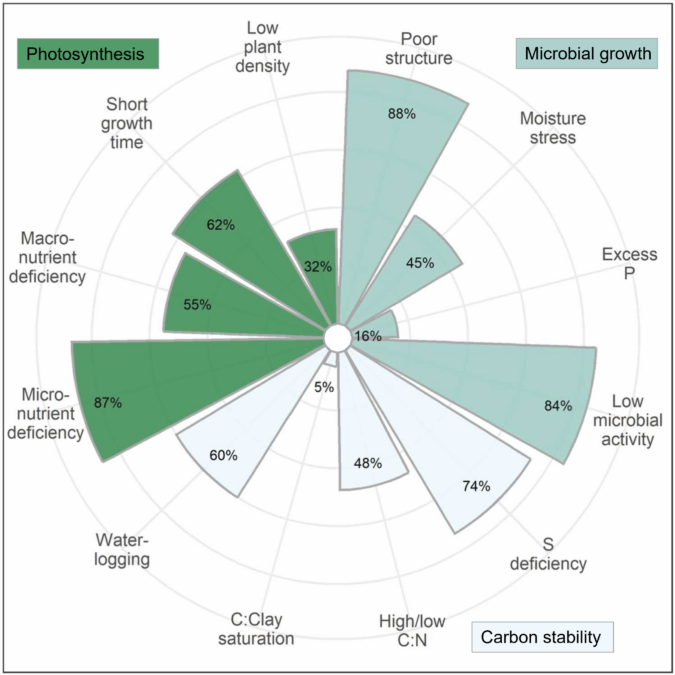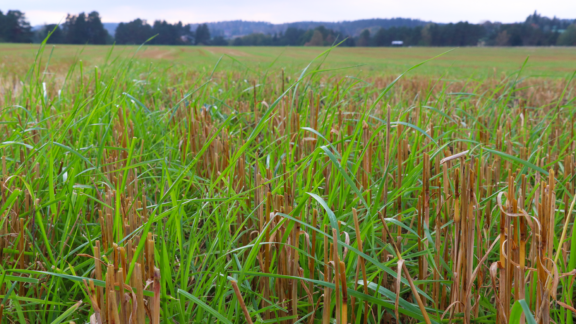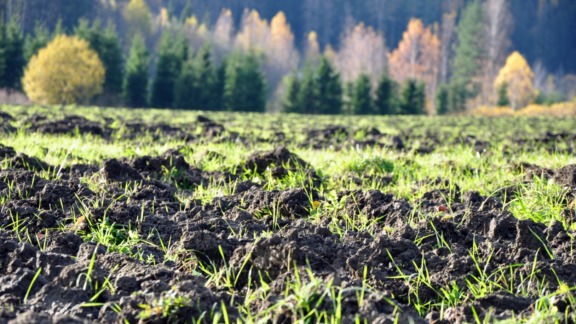Limitations to soil carbon sequestration in agriculture
Article: Agricultural limitations to soil carbon sequestration: Plant growth, microbial activity, and carbon stabilization
Authors: Mattila Tuomas & Vihanto Noora
Journal: Agriculture, Ecosystems & Environment
Year: 2024
The potential and actual yields are often far apart: how much plants could theoretically produce if they could use all the rainwater and sunlight – and how much they will eventually yield. The reasons for this discrepancy vary from region to region, but an overarching concept is soil health. Several approaches have been developed to determine soil health, including chemical (e.g. nutrients), physical (e.g. soil structure) and biological (e.g. soil organisms) factors.
Soil carbon sequestration
Soil carbon sequestration is limited by several factors. Among the most studied are nitrogen scarcity and the filling of the soil’s mineral surfaces, or saturation. This study looked at a number of factors limiting carbon sequestration on real farms working to increase carbon sequestration and participating in the Carbon Action pilot.
Carbon accumulation in soils has been divided into three phases in this study: 1) increased photosynthesis, 2) increased microbial growth and 3) decreased carbon loss (see figure). The order of the stages is not important, although they are numbered here, but they are interlinked. The limiting factors were similarly divided into these three stages:
- Photosynthesis is limited by the basic factors necessary for plant growth: sunlight, water and nutrients.
- Microbial growth is limited by
- poor soil conditions such as compaction, drought and poor gas exchange, and
- factors limiting microbial carbon uptake: temperature, humidity and substrate quality.
- The availability of nitrogen and sulphur limits the formation of organic matter and hence of stable forms of carbon. Both too low and too high carbon-to-nitrogen ratios limit persistence. Too much moisture can affect the persistence of accumulated carbon.
Microbial carbon use efficiency determines how much microbial biomass is produced from the carbon entering the soil from plants and regulates the formation of stable forms of carbon. Nutrient-rich organic residues (especially those with a suitable carbon-to-nitrogen ratio), stable moisture conditions and minimum disturbance increase the efficiency of microbial carbon use. Root exudates and their organic matter enhance microbial carbon use more than above-ground parts of the plant.

(Mattila & Vihanto 2024, edited from the original figure)
Factors limiting carbon sequestration – summary of results
- Several factors were limiting carbon sequestration in the studied fields, affecting all three stages of carbon sequestration.
- Factors that have received much attention in the past, such as nitrogen and phosphorus deficiency and carbon saturation, were not very common.
- On the other hand, a number of factors that have received less attention, such as poor soil structure, waterlogging and low microbial activity, were common.
- The main factor limiting photosynthesis and thus plant growth was the lack of leaf area, i.e. green vegetation, in spring and autumn and in mid-summer.
- Deficiencies of sulphur, manganese and boron were common
Factors limiting photosynthesis in the studied fields
- Photosynthesis was limited by a lack of leaf area at different stages of the growing season.
- Spring crops photosynthesized efficiently only in June and July, despite a 5-month growing season.
- Grass fields had high photosynthesis from May to October, but some pastures where grass was cut for hay had weak photosynthesis during the sunniest months of midsummer.
- The results suggest that crop productivity could be increased not only by expanding the length of the period with vegetation cover, but also by improving growing conditions to take full advantage of the best months of the growing season.
- Several of the fields showed nutrient deficiencies.
- A fifth of the fields studied had low cation exchange capacity and would benefit from an increase in organic matter.
- Most fields would not benefit from liming, but they had other problems.
- Some fields were also found to have excessive amounts of certain nutrients. Around one in six fields had phosphorus excess.
Factors limiting microbial activity
- Poor soil structure and periods of drought weakened the growing conditions for microbes.
- Soil temperature and humidity had large variations in during the growing season.
- Compactions were common in the studied fields.
- The survey showed that almost half of the fields were to some extent compacted. Three quarters of the soil profiles examined (200 samples) showed compaction in the topsoil.
- Only two of the 40 field plots surveyed were in excellent condition.
- The compacted layer was typically immediately below the plough layer from a depth of about 16 cm, but the depth varied considerably – in half of the fields it was between 6–21 cm.
- The compacted layer limited root growth. Since root carbon has been shown to be more likely to be stabilized in the soil than carbon from aboveground parts of the plant, a compacted layer near the surface can significantly impair soil carbon stocks.
- The compaction layer also limited water permeability, causing intermittent drying of the topsoil and high variability between drought and waterlogging.
- 60% of the fields studied had drainage problems.
- Poor soil structure and water conditions were also reflected in the low numbers of earthworms.
- Nutrient deficiencies and excesses can also limit the efficiency of microbial carbon use.
Relative amounts of nutrients, carbon and clay limiting carbon uptake
- Sulphur deficiency was very common (in three quarters of the studied fields), and it may limit the formation of stable carbon forms.
- All the fields surveyed are still far from carbon saturation.
- Carbon-to-clay ratio was so low in almost half of the fields that they were classified as degraded. This is an important finding for agricultural productivity.
- Soil wetting can cause the release of already fixed carbon



